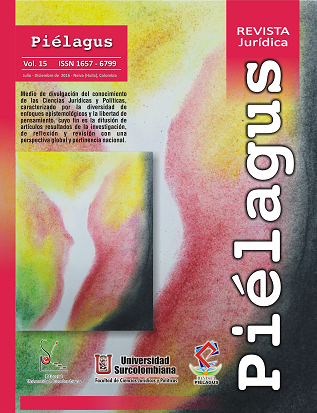Surgimiento de una constitución dual en una China transicional
##plugins.themes.bootstrap3.article.main##
Dado el asombroso desarrollo económico en las recientes décadas, es difícil para las teorías tradicionales, tanto las comunistas como las liberales, reflejar la realidad exacta de reforma en China. Conceptos como “Constitución no escrita” o “Constitución vigente” han sido estudiados en el contexto de China. No obstante, estos conceptos occidentales no muestran una mirada holística de la Constitución de China, especialmente después de 1978. La constitución de China, centrada en el Partido Comunista y en el Estado, ha sido transformada en gran medida.
Este artículo va más allá de los enfoques liberales y discute que una constitución dual ha brotado en China, con la cual la Constitución de los partidos busca mantener el ritmo con el Estado. Específicamente, el partido ha intentado integrarse al Estado a través de convenciones políticas y de una auto-normalización. La constitución dual es única en el sentido de que parte del modelo de Mao Zedong, desviándose de la Unión Soviética y
dejando de seguir un enfoque formalista de los países occidentales para definir la naturaleza de una constitución. Esto sugiere que el status quo del régimen de China y de la dirección de su propia reforma constitucional puede ser aclarado entendiendo la evolución de la constitución dual.
Descargas
##plugins.themes.bootstrap3.article.details##
·Alexy, R., (2005) “Balancing, Constitutional Review and Representation” 3 International Journal of Constitutional Law 572-581.
·Beijing News (2013). “Party Secretaries of 24 Provinces Assume the Chairman of Local People's Congress Standing Committee,” Xinjing Bao, 7 February.
·Callahan, W., (2013). China Dreams: 20 Visions of the Future (Oxford: Oxford University Press), p 5.
·Chang, W., (2011). “The Emergence of East Asian Constitutionalism: Features in Comparison” 59 (3) American Journal of Comparative Law 805-840.
·China: Update on the Independent Candidate Campaigns (2011). Visited on 27 March 2014, available at http://globalvoicesonline.org/2011/06/26/china-update-on-the-independent-candidatecampaigns
·Carter, L., (2012). “In China, Calls to Nationalize People's Liberation Army Increasingly Mainstream” (TeaLeafNation, 25 October). Visited on11 April 2014, available at http://www.tealeafnation.com/2012/10/in-china-calls-to-nationalize-peoplesliberation-army-increasingly-mainstream/#sthash.BCLS9y36.dpuf
·Communist Party of China News (2007). “New Measures to Enlarge the Intra-party Democracy to Elect Deputies for 17th National Congress”. Visited on 14 March 2014, available at http://cpc. people.com.cn/GB/104019/104109/6375733.html
·Dayuan, H., (2012). “Construct A Socialist Constitutionalism” Xin chanjing (New Industrial Economy), No. 4, pp. 40-43.
·Dicey, A., (1915). Law of the Constitution (London: Macmillan and Co., Limited), p 26.
·Dicey, A., (1982). Law of the Constitution (8th Edition) (USA: Liberty Fund Inc.), p 148.
·Dicey, A., (1959). Law of the Constitution (London: Macmillan Education Ltda.), pp 470-472.
·Dickson, B., (2014) “Who Wants to Be a Communist? Career Incentives and Mobilized Loyalty in China,” (2014) 217 The China Quarterly 42-68.
·Dingjian, C., (1998). “Zhongguo renmin daibiao dahui zhidu (People's Congress System in China” (revised edition). Beijing: Falv chubanshe, pp 359-360.
·Dowdle, M., (1997) “The Constitutional Development and Operations of the National People's Congress,” 11 (8) Columbia Journal of Asian Law 1-125.
·Dowdle, M., (2002). “Of Parliaments, Pragmatism, and the Dynamics of Constitutional Development: The Curious Case of China,” 35 (1) New York University Journal of International Law and Politics 10.
·Duanhong, C., (2008). “The Constitution as the Basic Law and the Higher Law in China,” Zhongwai faxue (Peking University Law Journal), Vol. 20, No. 4, p 508.
·Eulau, H., and Karps, P., (1977). “The Puzzle of Representation: Specifying Components of Responsiveness” 2 (3) Legislative Studies Quarterly 233-254.
·Freeman, E., (1876). The Growth of the English Constitution: From the Earliest Times (London: Macmillan and Co), pp 87, 109, 112.
·Hartcher, P., (2012) “Singapore a model for Chinese democracy” Sydney Moring Herald, October 30
·Hu, S., (1993) “Representation without Democratization: “Signature Incident” and China's National People's Congress” 2 (1) Journal of Contemporary China 14.
·International Herald Tribune (2011) “Communist Party of Vietnam: A Big Step Forward”. Visited on 11 August 2015, available at http://news.sina.com.cn/w/sd/2011-06-24/111522698677_2.shtml
·Kang, L., (2013). “Is China Dream a Good Example?”. Duke University, pp. 408 Renmin Luntan (People's Forum). Visited on 11 August 2015.
Available at http://theory.people.com. cn/n/ 2013/0627/c112851-21998223.html
·Le, Y., (2008). “Work Report of Zhengzhou Government was Vetoed at the session of the Standing Committee of LP” in Han Dayuan (ed.),
Zhongguo xianfa anshilie pingxi (Comments on Constitutional Incidents in China) (Beijing: Falv chubanshe), pp. 300-320.
·Li, E., (2013). “The Life of the Party,” 92 (1) Foreign Affairs 34-46.
·Lubman, S., (1999). Bird in a Cage: Legal Reform in China after Mao (Stanford: Stanford University Press), p 138.
·Mackerras, C., (2001). Donald McMillen and Andrew Watson, Dictionary of the Politics of the People's Republic of China. London: Routledge, p 74.
·McGregor, R., (2010) The Party: The Secret World of China's Communist Rulers. Penguin Group, p 15.
·O'Brien, K., (1990). Reform Without Liberalization: China's National People's Congress and the Politics of Institutional Change (Cambridge: Cambridge University Press), p 157.
·Pan Wei, P., (2009). “China Model: Achievements of 60 Years of PRC” Lvye (Green Leaf Journal), No. 4, pp 11-27.
·Peerenboom, R., (2002). China's Long March toward Rule of Law. Cambridge: Cambridge University Press, p 673.
·Peerenboom, R., (2003). “Beyond Universalism and Relativism: The Evolving Debates about Values in Asia” 14 (1) Indiana International Comparative Law ·Peerenboom, R., (2010). Judicial Independence in
China Cambridge: Cambridge University Press.
·Pei, M., (2012) “What China's Leaders Fear Most,” The Diplomat. Visited on 8 April 2014, available at http://thediplomat.com/2012/07/what-chinasleaders-fear-most/
·Pitkin, H., (1967). The Concept of Representation (Berkeley: University of California Press), pp 221-34.
·Qiangqiang, D., (2009). “Hunan People's Congress disapprove the Appointment of the Chief Procurator at Bingzhou City,” in Han Dayuan (ed.), Zhongguo xianfa anshilie pingxi (Comments on Constitutional
Incidents in China). Beijing: Falv chubanshe, pp 310-325.
·Qianfan, Z., (2010). “A constitution without constitutionalism? The paths of constitutional development in China” 8 (4) International Journal of Constitutional Law 955-956.
·Robust Theory of the Chinese Constitutional State: Between Formalism and Legitimacy in Jiang Shigong's Constitutionalism” 40 (2) Modern China 168-195.
·Sapio, F., (2008) “Shuanggui and Extralegal Detention in China,” 22 (1) China Information 7-33.
·Shigong, J., (2014). “Chinese-Style Constitutionalism: On Backer's Chinese Party-State Constitutionalism” 40 (2) Modern China 133-167 and Backer, L., (2014).
·Shigong, J., (2009). “Written and Unwritten Constitutions: A New Approach to the Study of Constitutional Government in China” 36 (1) Modern China.
·Sidel, M., (2009). The Constitution of Vietnam: A Contextual Analysis. Oxford: Hart Publishing, pp. 131.
·Sixi, C., (2010) “The Legislative Development over the Past Sixty Years in China,” Shanghai zhengfa xueyuan xuebao (Journal of Shanghai University of Political Science and Law), Vol. 25, No. 2 pp. 3-5.
·Sizhuo, Y., (2010). “Futurists Tell “China story”: Reading China's Megatrends” Mingzuo xinsheng (Masterpieces Review), No. 4, pp. 108-110.
·Tanner, M., (1994) “The Erosion of Communist Party Control over Lawmaking in China,” (1994) 138 The China Quarterly 381-403.
·Tsou, T., (2012). Twentieth Century Chinese Politics: From the Perspective of Macro-history and Micromechanism Analysis. Hong Kong: Oxford University Press. P 2.
·Tushnet, M., (2003). The New Constitutional Order. Princeton: Princeton University Press. P 1.
·Wheare, K., (1951). Modern Constitution (London: Oxford University Press), p 19.
·Xia, M., “The Communist Party of China and the “Party-State””. Visited on 19 March 2014, available at http://www.nytimes.com/ref/college/coll-chinapolitics-002.html
·Xiaojun, Y., (2011). “Regime Inclusion and the Resilience of Authoritarianism: The Local People's Political Consultative Conference in Post-Mao Chinese Politics” 66 China Journal 70.
·Xiaoli, Z., (2012). “On the Composition of the Deputies in the National People's Congress of China” 5 Tsinghua China Law Reivew 2-27
·Xiaoqing, Y., (2013). “Compare Constitutionalism with People's Democratic System” Hongqi wengao (Red Flag Manuscript), No. 10, pp.4-10.
·Xiaoyun W., (2015). “Delegates from Henan Province Question the Inequality of College Entrance Examination”. Visited on 11 August 2015, available at http://www.dahe.cn/xwzx/sz/t20090309_1501534.htm
·Xin, H., (2012) “Black Hole of Responsibility: The Adjudication Committee's Role in a Chinese Court,” 46 (4) Law and Society Review 681-712.
·Xin, H., (2012) “The Party's Leadership as a Living Constitution in China” 1 Hong Kong Law Journal 73-94 and Peerenboom, R., (2012) “Social Foundations of China's Living Constitution” in Ginsburg, T., (2012) ed., Comparative Constitutional Design (Cambridge: Cambridge University Press, 2012), pp 155-159.
·Xinhua News Agency, (2004). “Chronology of China's Constitutional Amendments”. Visited on 11 August 2015, available at http://www.china.org.cn/english/MATERIAL/89687.htm
·Xinwang, S., (2011). “Jiang Bikun: Qingli Diyibu Xianfa [Jiang Bikun: the Experience with the First Constitution in China]” Zhongguo xinwen zoukan (News Weekly), Vol. 514, No. 16, p 78.
·Yan, L., (2015) “Constitutional Evolution through Legislation: The Quiet Transformation of China's Constitution,” 13 International Journal of Constitutional Law 61-89
·Yang, Y., (1936). Jindai Zhongguo Lifashi (Legislative History of Modern China]. Shanghai: Shangwu yinshuguan.
·Young Nam, C., (2002). “From 'Rubber Stamps' to 'Iron Stamps': the Emergence of Chinese Local People's Congress as Supervisory Powerhouse” 107 China Quarterly 724-40.
·Yongkun, Z., (2011). “Several Issues on Unwritten Constitution” Fa xue (Legal Science Monthly), No. 3, pp 26-33.
·Yongnian, Z., (2013). “What Can be Reflected from the Controversial Issue over the Constitutionalism” Lianhe Zaobao, 18 June.
·Yongnian, Z., (2013). “Chinese Communist Party in New Era: Opportunities and Challenges,” Wuhan daxue xuebao (Journal of Wuhan University), Vol. 66, No. 3, p 15.
·Youyu, Z., (1983). “New Developments of the People's Congress System”, FBIS 15 (January 21): K12-15. From Renmin Ribao (People's Daily), 14 January, p 5.
·Zhixue, Z., (2013). “Realize the Essence of Constitutionalism” Dang jian (Party Construction), Vol. 29, No. 6, pp. 29-31.
·Zhiwei, T., (2014) “Judicial Neutrality: A Key Point to Improve Party's Leadership,” Yanhuang Chunqiu (Journal on China), No. 9, pp 1-8.
·Zhiwei, T., (2010). “A Comment on the Rise and Fall of the Supreme People's Court's Reply to Qi Yuling's Case,” 43 Suffolk University Law Review 669.

















